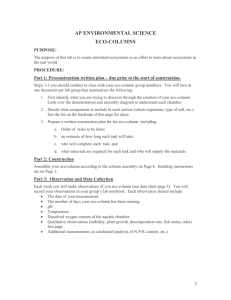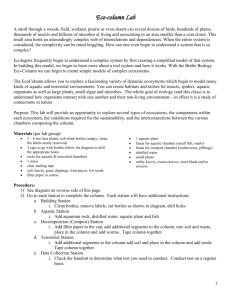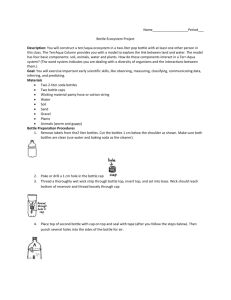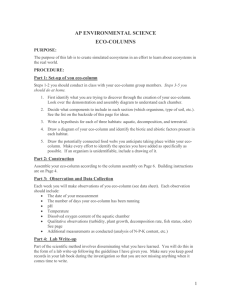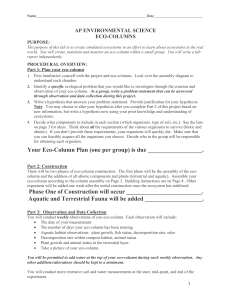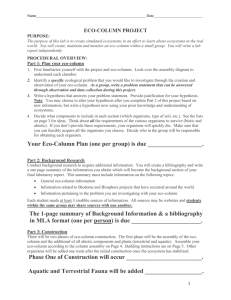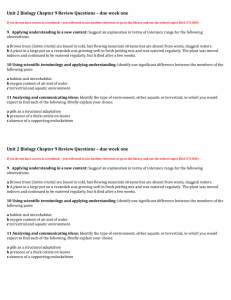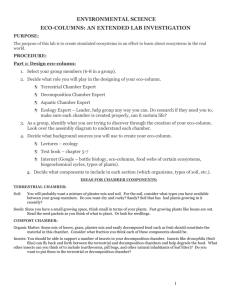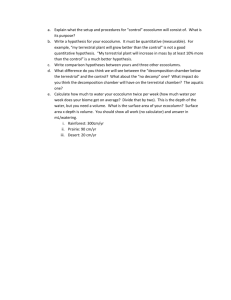Bottle Habitat - Trupia
advertisement
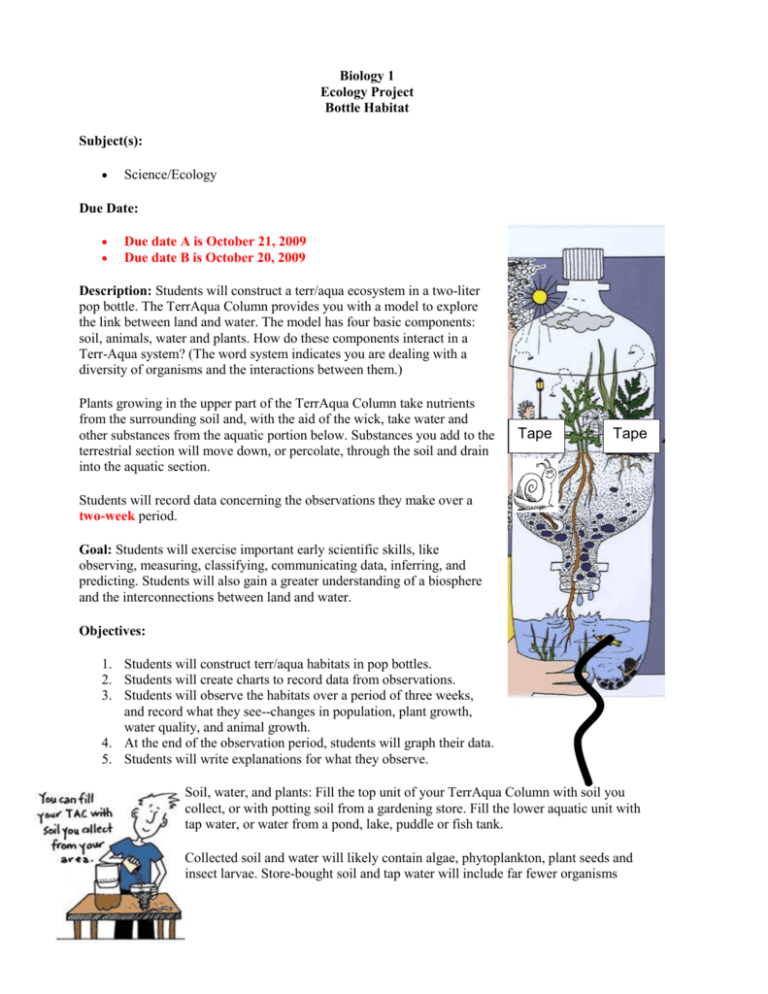
Biology 1 Ecology Project Bottle Habitat Subject(s): Science/Ecology Due Date: Due date A is October 21, 2009 Due date B is October 20, 2009 Description: Students will construct a terr/aqua ecosystem in a two-liter pop bottle. The TerrAqua Column provides you with a model to explore the link between land and water. The model has four basic components: soil, animals, water and plants. How do these components interact in a Terr-Aqua system? (The word system indicates you are dealing with a diversity of organisms and the interactions between them.) Plants growing in the upper part of the TerrAqua Column take nutrients from the surrounding soil and, with the aid of the wick, take water and other substances from the aquatic portion below. Substances you add to the terrestrial section will move down, or percolate, through the soil and drain into the aquatic section. Tape Tape Students will record data concerning the observations they make over a two-week period. Goal: Students will exercise important early scientific skills, like observing, measuring, classifying, communicating data, inferring, and predicting. Students will also gain a greater understanding of a biosphere and the interconnections between land and water. Objectives: 1. Students will construct terr/aqua habitats in pop bottles. 2. Students will create charts to record data from observations. 3. Students will observe the habitats over a period of three weeks, and record what they see--changes in population, plant growth, water quality, and animal growth. 4. At the end of the observation period, students will graph their data. 5. Students will write explanations for what they observe. Soil, water, and plants: Fill the top unit of your TerrAqua Column with soil you collect, or with potting soil from a gardening store. Fill the lower aquatic unit with tap water, or water from a pond, lake, puddle or fish tank. Collected soil and water will likely contain algae, phytoplankton, plant seeds and insect larvae. Store-bought soil and tap water will include far fewer organisms Terrestrial and aquatic plants are excellent indicators of change in your system. Fast-germinating and fast-growing plants will most effectively register change in a short period of time. Grasses, particularly lawn seed mixes, work well. Prairie grasses grow more slowly but have deep roots that are interesting to observe. Radishes and beans also work well, though you will need to soak dried beans overnight before planting. Variables: Variables to consider in your experiments include: The type and amounts of soil, water, and plants – remember, depending on their source, the soil and water will likely contain such life as algae, fungus, mites, Daphnia, etc. Substances that might affect terrestrial and aquatic systems – nutrients (fertilizers), or pollutants (salts, pesticides, acids). Physical factors – temperature, light, sound, etc. (Try singing or screaming at your plants.) Indicators: Indicators in a TAC are plants and animals and other system characteristics that change in response to your experiments, giving you information regarding your hypothesis. Indicators include terrestrial and aquatic plants and the soil and water. Some observations you can make of a plant indicator, for example, include percentage of seeds that germinate, plant height and weight, leaf size and shape, root structure, number of flowers, length of life cycle and seed production. In the aquatic system, indicators include increases or decreases in populations of algae and duckweed. These changes can show up as cloudiness in the water. Experimentation with the TerrAqua Column is practically unlimited. Materials Two 2-liter soda bottles Two bottle caps Wicking material-fabric interfacing or cotton string Water, soil, animals and plants Step 1 – Remove label from the 2-liter bottle. Cut bottle 1 cm below shoulder. Bottle #1 Step 2 – Poke or drill a 1 cm hole in bottle cap. Step 3 – Thread a thoroughly wet wick strip through bottle top, invert top, and set into base. Wick should reach bottom of reservoir and thread loosely through cap. Step 4 – Fill reservoir with water, aquatic animals and plants. Add soil, terrestrial animals and plants to top chamber. To be effective, the wick should run up into soil, not be plastered along a side of the bottle. For better drainage, place a layer of gravel, sand or vermiculite in the bottom of the soil unit. Step 5 – Remove label from the 2-liter bottle. Cut bottle 1 cm below shoulder. Bottle #2 Step 6 – Place top of second bottle with cap on top and seal with tape. Then punch several holes into the sides of the bottle for air. Air holes For Stocking It’s very important that all materials introduced into the TerrAqua Column — living, dead, or nonliving — are clean and free of anything that might be toxic to living things (e.g., oil, pesticides, etc.). The organisms you introduce should be small and suited to the habitats you construct. The number of organisms you introduce will depend on what they are but it is generally best to err on the side of adding too few than too many, especially in the aquatic habitat. Bigger organisms should definitely be limited to one or two. Over a two week period, the students will record daily observations, looking for plant growth or population changes. Take quantitative measurements (exactly how many? exactly what size? how many days?) as well as qualitative (what color? what shape? slow or quick movement?). At the end of the observation period, the students will graph the information they've obtained through observation. At this time, they should write hypotheses to explain some of the things they've seen. Aquatic habitat Fine grained aquarium gravel (provides “bedrock”) Sand or topsoil (provides bottom sediment) Untreated tap water or distilled water (provides aquatic habitat) “Boulders,” “sunken logs,” and other miniature objects typical of a pond bottom Aquatic plants and animals Fish food (if you include a fish) Terrestrial habitat Fine grained aquarium gravel (provides “bedrock”) Topsoil (provides soil substrate) Leaf litter (provides decaying material) Terrestrial plants and animals “Boulders,” “dead trees,” and other miniature objects typical of a forest habitat Food for animals as needed Exact Procedure: Aquatic habitat 1. 2. 3. 4. Add a layer of sand or topsoil (2-3 cm) to the deep base. Add a layer of gravel (1-2 cm) on top of the sand or topsoil. Add water to a level about 1 cm below the cap of the inverted deep funnel. Plant aquatic plants in the bottom sediment. A chopstick or skewer will help you push the stems or roots into the ground. 5. Arrange “boulders” and other objects on the bottom sediment. 6. Add floating aquatic plants. 7. Add aquatic animals. Terrestrial habitat 1. Add a layer (1-2 cm) of gravel to the deep funnel. 2. Mix equal parts of leaf litter and topsoil together, moisten, and add a layer (6-8cm) over the gravel. 3. Add terrestrial animals that burrow to the soil (e.g., worms). 4. Plant terrestrial plants in the soil. 5. Arrange “dead trees” and other objects on the soil. 6. Add terrestrial animals. 7. Establish a “water connection” between the aquatic and terrestrial habitats by holding the terrarium over the aquarium at a slight angle and slowly pouring water down the side of the terrarium until it drips from the “wick” into the aquarium. This is essential to ensure “wicking” action. Maintenance Instructions Provide a light source, preferably indirect window light. A small desk lamp or plant light will work, too. For artificial lights, provide 12 –14 hours of light daily. If you place your project outside, make sure it is in a covered area , so that it does get light, but it is protected from too much of the elements (rain, sun, and other animals). Assessment: Are the aquaria appropriately stocked? Have they been well-maintained? Are observations recorded at regular intervals? Are graphs drawn correctly? Are hypotheses based in fact? You must turn in the following for evaluation: Bottle Habitat with plants, animals, soil and water. Typed written purpose, hypothesis, materials, list of types of plants, animals, soil and water that were used for your project., data table (dates, growth measurements of each organism, and other observations), graph of data, conclusion Daily observations of your habitat, including dates and specific information. Students will observe the habitats over a period of two weeks, and record what they see-changes in population, plant growth, water quality, and animal growth. At the end of the observation period, students will graph their data. Ecology Biosphere Project Rubric 4 3 2 1 Purpose/Problem Purpose of the project is well stated, clear and accurate Purpose of the project is somewhat stated, and accurate Purpose of the project is vague, unclear and/or inaccurate Purpose of the project is missing Hypothesis Hypothesis is stated, clear and well developed Hypothesis is stated and somewhat developed Hypothesis is stated and unclear Hypothesis is not stated Experiment All Terrestrial and Aquatic organisms are listed accurately and all food sources and environmental needs are substantially addressed Terrestrial and Aquatic organisms are listed accurately, but food sources and environmental needs are somewhat substantially addressed Terrestrial and Aquatic organisms are listed inaccurately and no food sources and/or environmental needs addressed Terrestrial and Aquatic organisms are not listed Design and Development All steps in the procedure were followed accurately and the design is neat and clean Most steps in the procedure were accurately followed and the design is neat and clean Few steps in the procedure were followed and the design is unkempt and dirty Steps in the procedure were not followed and design is unkempt and dirty CATEGORY Data: Observations Data was collected over the entire two weeks on a daily basis. It clearly describes what was observed in complete sentences. Data was collected for more than one weeks. It clearly describes what was observed in complete sentences. Data was collected a few times. Observations were not clear and/or incomplete. Data was not collected Conclusion/Summary Student provided a detailed conclusion clearly based on the data and related to research findings and the hypothesis statement(s). Student provided a somewhat detailed conclusion clearly based on the data and related to the hypothesis statement(s). Student provided a conclusion with some reference to the data and the hypothesis statement(s). No conclusion was apparent OR important details were overlooked.
